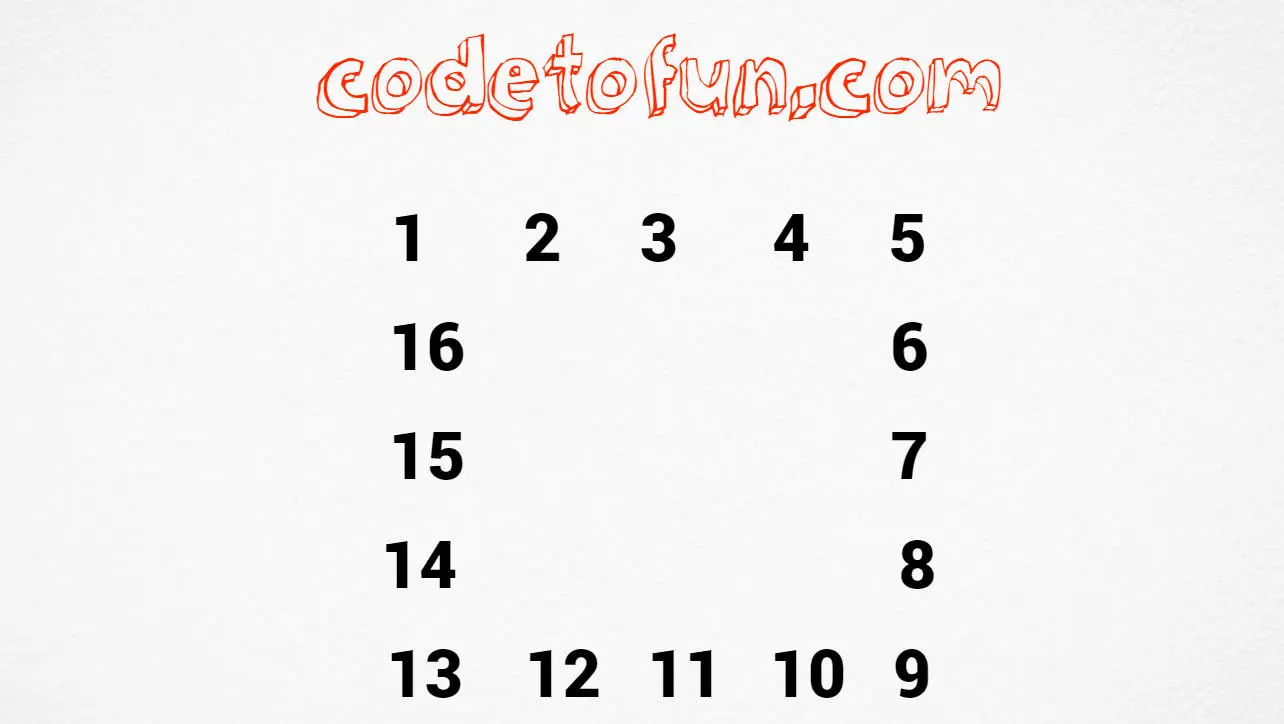
C++ Topics
- C++ Intro
- C++ String Functions
- C++ Interview Programs
- C++ Star Pattern
- C++ Number Pattern
- Number Pattern 1
- Number Pattern 2
- Number Pattern 3
- Number Pattern 4
- Number Pattern 5
- Number Pattern 6
- Number Pattern 7
- Number Pattern 8
- Number Pattern 9
- Number Pattern 10
- Number Pattern 11
- Number Pattern 12
- Number Pattern 13
- Number Pattern 14
- Number Pattern 15
- Number Pattern 16
- Number Pattern 17
- Number Pattern 18
- Number Pattern 19
- Number Pattern 20
- Number Pattern 21
- Number Pattern 22
- Number Pattern 23
- Number Pattern 24
- Number Pattern 25
- Number Pattern 26
- Number Pattern 27
- Number Pattern 28
- Number Pattern 29
- Number Pattern 30
- Number Pattern 31
- Number Pattern 32
- Number Pattern 33
- Number Pattern 34
- Number Pattern 35
- Number Pattern 36
- Number Pattern 37
- Number Pattern 38
- Number Pattern 39
- Number Pattern 40
- Number Pattern 41
- Number Pattern 42
- Number Pattern 43
- Number Pattern 44
- Number Pattern 45
- Number Pattern 46
- Number Pattern 47
- Number Pattern 48
- Number Pattern 49
- Number Pattern 50
- Number Pattern 51
- Number Pattern 52
- Number Pattern 53
- Number Pattern 54
- Number Pattern 55
- Number Pattern 56
- Number Pattern 57
- Number Pattern 58
- Number Pattern 59
- Number Pattern 60
- Number Pattern 61
- Number Pattern 62
- C++ Alphabet Pattern
C++ Number Pattern 59

Photo Credit to CodeToFun
C++ Number Pattern 59
Here`s a program that prints the above number pattern using C++ Programming:
#include <iostream>
#include <iomanip>
using namespace std;
int main() {
int i, j;
int k = 6, l = 13, m = 16;
for (i = 1; i <= 5; i++) {
for (j = 1; j <= 5; j++) {
if (i == 1)
cout << setw(3) << j;
else if (j == 5)
cout << setw(3) << k++;
else if (i == 5)
cout << setw(3) << l--;
else if (j == 1)
cout << setw(3) << m--;
else
cout << " ";
}
cout << "\n";
}
return 0;
}
💻 Testing the Program
When you run the above program, it will print the following output:
1 2 3 4 5
16 6
15 7
14 8
13 12 11 10 9
🧠 How the Program Works
Let's break down the logic behind the code:
- The program includes two C++ standard libraries: iostream and iomanip. The iostream library is used for input and output operations, and iomanip is used for formatting the output.
- The using namespace std; line brings all the names from the std namespace into the current scope, so you can use names like cout, cin, etc., without explicitly specifying std:: before them.
- The main() function is the entry point of the program.
- Three integer variables k, l, and m are declared and initialized with the values 6, 13, and 16, respectively.
- The program enters a nested for loop. The outer loop runs from i = 1 to i <= 5, and the inner loop runs from j = 1 to j <= 5.
- Inside the nested loops, there are conditional statements (if-else) to determine what to print at each position in the 5x5 grid.
- If i == 1, it prints the value of j with a width of 3 characters using setw(3). This means the output will be right-aligned and take up 3 characters of space.
- If j == 5, it prints the value of k with a width of 3 characters using setw(3) and then increments k by one.
- If i == 5, it prints the value of l with a width of 3 characters using setw(3) and then decrements l by one.
- If j == 1, it prints the value of m with a width of 3 characters using setw(3) and then decrements m by one.
- If none of the above conditions is true (i.e., for all the other positions in the grid), it prints three spaces, creating an empty space.
- After each row is printed, the program adds a new line character \n to move to the next row.
- The loop continues until all the rows and columns of the 5x5 grid are printed.
- Finally, the main() function returns 0, indicating successful program execution.
💯 Tips for Enhancement:
Explore the versatility of this pattern by adjusting its parameters. Whether you increase or decrease the size, tweak the spacing, or modify the characters used, each change opens up a world of possibilities, allowing you to customize and create your unique visual effects.
✔ Conclusion:
Creating visually appealing patterns is not only a fun endeavour but also a great way to enhance your programming or design skills. We hope this tutorial has inspired you to explore the world of creative coding. Share your creations with us, and let your imagination run wild!
🤗 Closing Call-to-Action:
We'd love to see your unique interpretations of the number pattern. Share your creations in the comments below, and don't hesitate to reach out if you have any questions or suggestions for future tutorials. Happy coding!
👨💻 Join our Community:
Author

For over eight years, I worked as a full-stack web developer. Now, I have chosen my profession as a full-time blogger at codetofun.com.
Buy me a coffee to make codetofun.com free for everyone.
Buy me a Coffee












If you have any doubts regarding this article (C++ Number Pattern 59) please comment here. I will help you immediately.